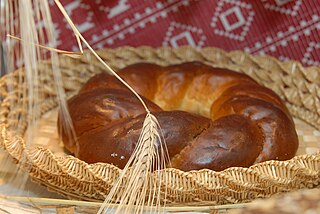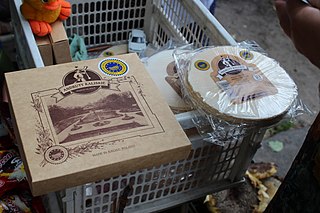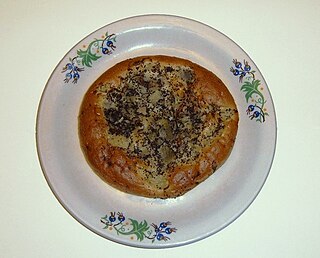
Kolach or kalach is a traditional bread found in Central and Eastern European cuisines, commonly served during various special occasions – particularly wedding celebrations, Christmas, Easter, and Dożynki. The name originates from the Old Slavonic word kolo (коло) meaning "circle" or "wheel". Korovai is sometimes categorised as a type of kolach.

Zwoleń County is a unit of territorial administration and local government (powiat) in Masovian Voivodeship, east-central Poland. It came into being on January 1, 1999, as a result of the Polish local government reforms passed in 1998. Its administrative seat and only town is Zwoleń, which lies 104 kilometres (65 mi) south-east of Warsaw.

Sława is a town in Wschowa County, Lubusz Voivodeship, in western Poland, with 4,321 inhabitants (2019). It is situated on the eastern shore of Lake Sławskie.

Silesian dumplings are potato dumplings traditional to the wider Silesia region of Poland and Germany. They are also called białe kluski.
Nockowa is a village in the administrative district of Gmina Iwierzyce, within Ropczyce-Sędziszów County, Subcarpathian Voivodeship, in south-eastern Poland. It lies approximately 3 kilometres (2 mi) south-east of Iwierzyce, 14 km (9 mi) south-east of Ropczyce, and 16 km (10 mi) west of the regional capital Rzeszów.

Siedlisko is a village on the Oder river in Nowa Sól County, Lubusz Voivodeship, in western Poland. It is the seat of the gmina called Gmina Siedlisko. It lies approximately 8 kilometres (5 mi) south-east of Nowa Sól and 29 km (18 mi) south-east of Zielona Góra.

Piekło is a village in the administrative district of Gmina Sztum, within Sztum County, Pomeranian Voivodeship, in northern Poland. It lies approximately 12 kilometres (7 mi) west of Sztum and 51 km (32 mi) south of the regional capital Gdańsk.

Redykołka is a type of cheese produced in the Podhale region of Poland. It is sometimes known as the "younger sister" of the Oscypek cheese and the two are occasionally confused. The similarity comes from the fact that redykołka is traditionally made using leftover Bundz from Oscypek production.

Prądnik bread - is a traditional secale bread baked in Kraków. The bread may be produced in huge loaves amounting to 14 kg. It is a protected produce, under geographical indications and traditional specialities in the European Union.

The Kalisz andruts, also simply known as andruts, are lightly sweet, flat wafers first recorded to be baked at the beginning of the nineteenth-century in Kalisz and the Kalisz Region.

Pampuchy are a type of steamed yeast dumpling (kluski) or doughnut (pączek) in Polish cuisine. A cooked pampuch (sing.) has an oval, flat on the bottom shape, with a bouncy, mushy and soft consistency. Pampuchy or bułki na parze are served hot: either sweet or savoury.
Biłgoraj pieróg is a traditional Polish regional dish, originating from Biłgoraj Land, formerly prepared for important celebrations and holidays.
Opole cuisine is an umbrella term for all dishes with a specific regional identity belonging to the region of Opole. It is a subtype of Polish and German cuisine with many similarities to and signs of the influence of neighbouring cuisines.
Podlaskie cuisine is an umbrella term for all dishes with a specific regional identity belonging to the region of Podlaskie. It is a subtype of Polish, Lithuanian and Belarusian cuisine with many similarities to and signs of the influence of neighbouring cuisines.
Lublin cuisine is an umbrella term for all dishes with a specific regional identity belonging to the region of Lublin. It is a subtype of Polish and Galician cuisine with many similarities to and signs of the influence of neighbouring cuisines.
Świętokrzyskie cuisine is an umbrella term for all dishes with a specific regional identity belonging to the region of Świętokrzyskie. It is a subtype of Polish and Galician cuisine with many similarities to and signs of the influence of neighbouring cuisines.

Cebularz is a wheat dough pancake in Polish and Ashkenazi Jewish cuisine, with a diameter of 15-20 cm, topped with diced onion and poppy seed (15-20%), characteristic for Lublin cuisine.

In Polish cuisine, kluchy połom bite is a traditional and regional kluski made from specially whipped potatoes entwined with flour, characteristic for the Gmina Kroczyce. In other regions of Poland the dish is known by other names, including prażucha ziemniaczana and fusier.

Powiśle or Dolne Powiśle is a cultural and geographic region in northern Poland, administratively located in the Pomeranian and Warmian-Masurian Voivodeships.













